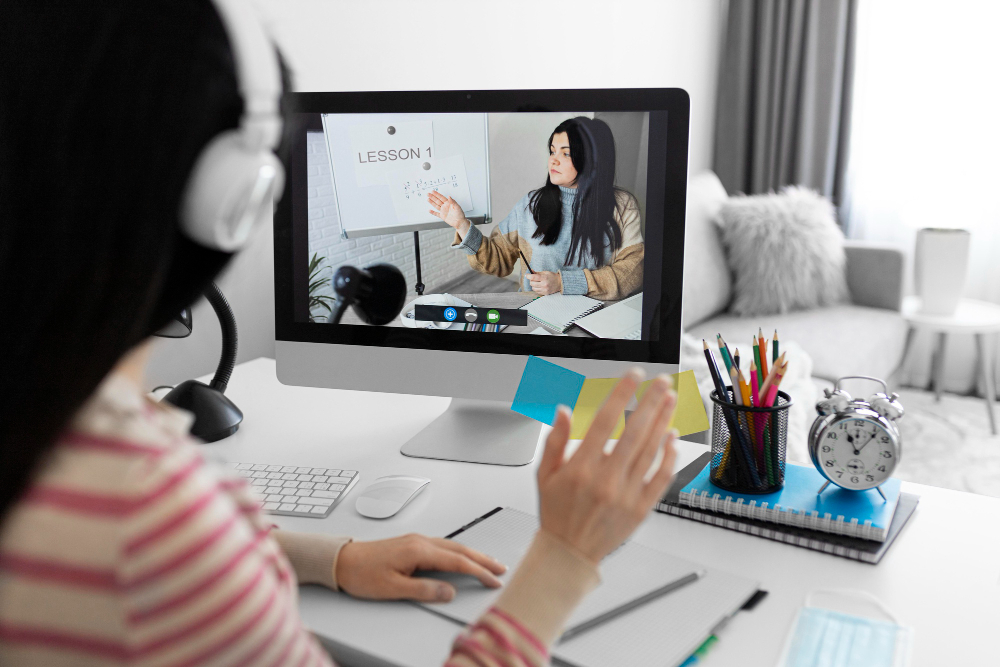How to Create a Virtual Classroom in Easy Steps

Strong 8k brings an ultra-HD IPTV experience to your living room and your pocket.
Suppose you're in the business of any form of training and education program, in that case, you may be aware of the significance of virtual classrooms. In the age of everything happening on the internet, the web space is rapidly expanding into the largest digital platform, which is why virtual learning or classrooms form a large component of this. That’s why it is important to understand how to set up virtual classrooms.
In the last few years, several schools, and even other institutions have started offering virtual classes. These proved to be a huge benefit in providing a high-quality education for students without risking their health. Virtual classroom app development is more than just a method for teachers and students to better communicate via video online.
However, even though online training sessions have benefits, setting up a classroom online can be a challenge. A sudden change from traditional classrooms to online learning has left many teachers in a state of uncertainty and fear. To overcome this abrupt shift, it is essential to understand how to teach online, which can increase student engagement and create an efficient interaction between teachers and students.
What Is a Virtual Classroom?
Virtual classrooms are online learning platforms that mimic the physical class, employing interactive and digital devices such as learning management systems, online assessment software, and more. Create an online classroom to provide the benefits of synchronous learning (instructors and learners interact live using videoconferencing software) or asynchronous education (instructors and learners sign in to the virtual world whenever they want). Synchronous learning can be achieved through online courses featuring videos, slides, quizzes, recorded lectures, homework, and other teaching resources.
A virtual classroom is where the usual elements of education--lectures, discussions, group projects, and even presentations are conducted using digital technology. Teachers can present live lectures or share materials and assess students' progress through quizzes and assignments, all in the virtual classroom. The classrooms usually include a more extensive Learning Management System or LMS which allows you to manage online courses, manage materials, monitor the participation of students, and manage administrative duties.
Many schools, corporations, and the federal and state governments are increasingly dependent on virtual environments. This change is directly resulting from the expanding usage of technology in education. Now, the focus is on making content that is not only informative but relevant and useful to today's learners.
Benefits Of Virtual Classrooms
The virtual classroom is at the center of online degree programs. It's an ideal, central space allowing you to take classes. There are many similarities between a traditional campus-based educational system and an online college course. The learning experience through on-demand e-learning app development offers several advantages traditional college degrees do not provide. Below are some of them we included on our list of the top benefits:
Ability To Access Coursework Anywhere, Anytime
The freedom is yours to work on and finish your course whenever it is convenient for your schedule. When you're not in town on business, studying in your hotel room, waiting for a connecting flight, or meeting is possible. All you require is a laptop or another digital gadget.
When you sign in to the student portal via the university's online website, you're now in the school. Students can view assignments, submit assignments, view faculty talks, take part in student discussions, and conduct research. You can also contact your instructor and fellow students, get help from students' support services, get feedback, and check the test scores.
Effective Time Management
A virtual education can provide an ideal environment for adults who must balance their work schedule and home life with the ever-changing needs of attending classes. You can immediately save time each week without being required to drive between courses at a school, and that's only the start. Returning to school improves time management skills, as it is imperative to stay disciplined and find space to do your studies.
Feedback On Tests Immediately
If you're in one of the numerous degrees that are available online that you can choose from, you won't need to be concerned about waiting weeks for results. Tests are conducted on the internet and generally scored once you've finished.
It is easy to see what you performed well and the areas that require improvement. Suppose you have to submit your papers and assignments. In that case, you'll be using the private "Dropbox," where your instructor can access your work privately and will provide you with either video or written feedback.
Sharpened Digital Skills
As you increase your understanding and capabilities in your chosen field of interest, you'll improve your skills with the most advanced technological tools for learning online. When you continue to study and work online, you'll be confident and efficient using interactive online instruments.
Easy Steps To Creating a Virtual Classroom
The creation of a virtual classroom may initially seem daunting for teachers, but in the real world, it's simple. If you're an educator looking to incorporate a virtual classroom design into your teaching strategies or a business that wants to train staff, implementing the virtual classroom requires an arduous planning process that is executed through a series of actions.
If you follow these steps, you will be able to create a highly effective and collaborative virtual learning space that is ideal for your students.
Define Your Learning Objectives
It is crucial to determine the goals of creating a virtual classroom. Ask yourself questions like:
- What will one be able to discover from this procedure?
- Who are your potential clients?
- What will you do to monitor the progress?
Here are the main goals of the virtual classroom. These goals can help guide decisions about designing the virtual classroom to meet the educational goals.
Choose The Right Platform
The kind of online classroom chosen is crucial when it comes to selecting the best one. Numerous options are available, and each one has its own unique characteristics. A few aspects to be considered are user-friendliness and expandability, as well as compatibility with different software and other alternatives, like whiteboards with separate areas for discussion and screen sharing.
Establishing The Virtual Classroom Space
Once you've decided on the best platform, the next thing to do is to set up your virtual classroom. This involves adjusting aspects like arrangement and uploading the items that might be required in general, as well as the settings that are required to allow teaching in a virtual environment.
Consider the structure of your information if you decide to include discussion boards and what you'll do to moderate them. Also, it is essential to constantly monitor the surroundings to ensure that all activities flow into place as planned before the first meeting.
Prepare Your Teaching Materials
In the context of a virtual classroom, all online instructional strategies or content you are considering as a resource needs to be digital and easily accessible. Examples are PowerPoint videos, displays documents, handouts, texts, and other activities like questions, games, or polls.
You must consider using multimedia as students are prone to quickly becoming bored. In this case, you can include informational videos, and other engaging things that learners learn from lessons and their learning styles.
Plan For Interactivity
Including students in the education process is logical, as interactivity helps make an environment more engaging. To encourage participation, create inclusive activities such as discussions, polling, or other collaborative projects. You can try using alternatives such as breakout rooms for small-group discussions or collaborative boards to create real-time problem-solving areas. Interactivity is growing in popularity, making your virtual class more interesting and stimulating so pupils can stay on task.
Conduct a Test Run
Education app development company conduct the free version of the mock session in a small group to ensure all functions are working correctly. You can become acquainted with the system's features, debug any issues, and enhance learning. Trials let you verify that you're comfortable and in good space, specifically during your initial teaching class.
Launch and Monitor Your Virtual Classroom
Once everything is in place and ready to live, you can begin your online classroom or even in-person. The first thing to start is to conduct an introduction to the virtual classroom for your students to learn about the technology and ways they can participate.
Throughout the course, you should observe the students' activities, collect feedback, and modify the curriculum as needed. Be sure to take the time to think every now and then to determine if the classroom is operating as efficiently.
Conclusion
Nowadays, we can all acknowledge that education has been shifting to online learning, with virtual classes at the forefront of this transformation. As more and more schools and teachers embrace virtual learning, there's always a demand for technologically advanced, easily-to-use flexible, and adaptable educational platforms. These platforms offer the possibility of academic advancement and innovative ideas for collaboration and control of students in a virtual class.
Virtual classrooms can provide various benefits that make them worthwhile for teachers and educational institutions. With this development growing and the need for better education, it's essential for private equity companies to put their money into the appropriate equipment to make sure they do not get swept away.
https://www.fullestop.com/education-app-development.php
Note: IndiBlogHub features both user-submitted and editorial content. We do not verify third-party contributions. Read our Disclaimer and Privacy Policyfor details.







